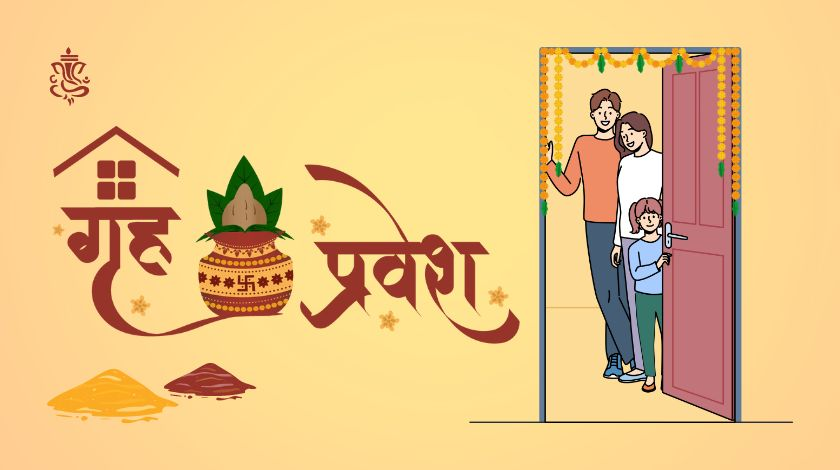Best Griha Pravesh Muhurat in 2025-26 (Month Wise)

Introduction: Why Griha Pravesh Is More Than Just a Ritual
A home is more than just four walls and a roof—it’s where dreams unfold, bonds are nurtured, and memories are made. But before all of that begins, it’s essential to ensure that the energy within your new space is in harmony with the cosmos. That’s where the Griha Pravesh ceremony comes in—a sacred and time-honored ritual in Indian tradition, performed to sanctify your home and invoke divine blessings. Whether you’re moving into a newly constructed property, shifting into a rented apartment, or re-entering a house after renovation, the right Griha Pravesh muhurat in 2025 can make a world of difference. This isn’t just about tradition—it’s about ushering in good fortune, prosperity, and peace.
In this detailed guide, we cover monthly auspicious muhurats, the astrological significance, days to avoid, puja dos and don’ts, and even interesting facts that make this ritual timeless. By the end, you’ll be fully equipped to plan a flawless housewarming in 2025, aligned with Vaastu Shastra, astrology, and positive energy—because moving in isn’t just about boxes, it’s about blessings.
-
What is Griha Pravesh, and why does it matter?
Griha Pravesh—also known as the Hindu house-warming or home-entry ceremony—is a sacred ritual performed when moving into a new, rebuilt, or renovated home. It removes negative energies, aligns the space with Vaastu Shastra and cosmic vibrations, and invites prosperity, health, and harmony. When timed with an auspicious muhurat (Vedic auspicious time), the ceremony amplifies blessings and long-term wellbeing.
-
How do I calculate the most auspicious muhurat for Griha Pravesh?
Calculating a favorable muhurat involves:
- Tithi (lunar day): Prefer Dwitiya, Tritiya, Panchami, Saptami, Dashami, Ekadashi, Dwadashi, Trayodashi in the Shukla Paksha (waxing moon).
- Nakshatra: Rohini, Mrigashirsha, Uttar Phalguni, Chitra, Revati, Uttara Ashadha, and Uttara Bhadrapada are highly beneficial.
- Weekday: Thursday, Friday, or Sunday preferred; avoid Tuesday, Saturday, and sometimes certain Sundays.
- Avoid Rahu Kaal, daily half-hour windows when activities are inauspicious.
- Lunar month: Do not hold Griha Pravesh during Ashadha, Shravana, Bhadrapada, Ashwin, or Pausha.
-
What is the significance of Choghadiya in house shifting?
Choghadiya divides day and night into eight segments, each ruled by a deity or planet. These segments indicate auspicious or inauspicious times for significant activities like moving into a home. For Griha Pravesh, choose from Amrit, Shubh, or Labh Choghadiya to ensure positive outcomes, avoid Rog, Kaal, and Udveg. Incorporating Choghadiya adds Vaastu accuracy and cosmic harmony.
-
Which days in 2025 should be avoided for Griha Pravesh?
Avoid the following:
- Tuesday: Mars-ruled, brings aggression and conflict.
- Saturday: Saturn-ruled, delays and obstacles.
- Certain Sundays, when combined with inauspicious tithis.
- Months to avoid: Ashadha (Jul–Aug), Shravana, Bhadrapada, Ashwin (Sep–Oct), Pausha (Dec–Jan).
-
What are the best days of the week for house shifting?
For a smooth and harmonious move-in, plan Griha Pravesh on:
- Thursday: Promotes wisdom, expansion, and goodwill.
- Friday: Brings prosperity, comfort, and beauty.
- Sunday: Invites success, vitality, and positive energy.
Mixing weekday significance with the right lunar tithi and nakshatra maximizes ritual impact.
-
Which weekdays should I avoid for house shifting?
Avoid:
- Tuesday: Symbolizes conflict and haste.
- Saturday: Can result in delays, challenges, and obstacles.
If unavoidable due to logistical concerns, choose the least inauspicious tithi and nakshatra and avoid Rahu Kaal and general ill-days.
-
What are inauspicious time slots for house shifting?
Daily Rahu Kaal varies each day and must be avoided. Approximate timings:
- Monday: 7:30–9 AM
- Tuesday: 3–4:30 PM
- Wednesday: 12–1:30 PM
- Thursday: 1:30–3 PM
- Friday: 10:30–12 PM
- Saturday: 9–10:30 PM
- Sunday: 4:30–6 PM
Additionally, avoid Gulika, Yamagandam, and segments like Rog, Kaal, and Udveg Choghadiya.
-
Which festivals are auspicious for Griha Pravesh?
These festivals amplify the ritual’s blessings:
- Basant Panchami (February) – for educational growth and harmony
- Akshaya Tritiya (April/May) – symbol of eternal prosperity
- Dussehra (September/October) – marks the victory of good
- Dhanteras & Diwali – perfect for inviting beauty, luck, and financial success
Celebrating Griha Pravesh on these days aligns with high cosmic energies.
-
Which festivals should I avoid for Griha Pravesh?
It’s best to avoid:
- Makar Sankranti, Holi, and other transitional festivals, when energies are in flux
- Full-moon (Purnima) and New-moon (Amavasya) days, seen as energetically unstable
- Mourning days, eclipse periods, and personal astrology hardship days
-
What are auspicious ascendants (Lagna) for Griha Pravesh?
Ascendant charts (Janma Lagna) convey the starting energy. Rathore astrologers recommend:
- Cancer, Leo, Libra, Virgo, and Aquarius—they bring stability, prosperity, and peace into the home environment.
-
Which lunar dates (Tithis) are best for Griha Pravesh?
Ideal shukla paksha tithis:
- Dwitiya, Tritiya, Panchami, Saptami, Dashami, Ekadashi, Dwadashi, Trayodashi
Avoid Krishna Paksha, Purnima, Amavasya, and eclipses.
-
What are the dos and don’ts of Griha Pravesh?
Dos:
- Clean and sanitize before puja
- Boil milk in every room until it overflows
- Place Kalash with Ganga water and mango leaves
- Break a coconut at entry threshold
- Light sacred lamps and lamps in every room
- Invite all healthy family members
- Feed Brahmins or community as tradition
Don’ts:
- No speaking during mantras
- Do not pee/vomit during ceremony
- Don’t move furniture pre-ceremony
- Avoid participation by anyone ill or upset
- Don’t keep weapons, alcohol or negative symbols
-
Should you perform Griha Pravesh for a rented house?
Yes—renters can also benefit. Purpose:
- Remove residual energies from previous occupants
- Establish emotional and energetic ownership
- Mark a fresh beginning aligned with positive vibrations
Use similar rituals—milk overflow, lamp, coconut break—for cleansing and good energy.
-
How do you prepare the house for Griha Pravesh?
- Deep cleaning and airy ventilation
- Whitewash or safe wall paints
- Declutter all rooms including kitchen, shrines, bathrooms
- Place fresh flowers and rangoli at the entrance
- Gather all puja items: Kalash, lamp, turmeric, sandalwood, coconut, sweets, incense
- Confirm guest/priest arrival, Logistics (bell working, power, water supply)
-
What interesting facts are there about Griha Pravesh puja?
- First grain entry ritual: symbolic of nurturing wealth
- Navagraha pooja: balances planetary forces
- Vastu Shanti enhances energetic alignment
- Virtual puja trend: online participation by relatives gaining popularity
- Milk overflow symbolism: representing boundless prosperity
-
Which are the best Griha Pravesh dates in 2025? (Monthly tables)
Griha Pravesh Muhurat in February 2025
| Date | Tithi & Nakshatra | Time |
| Feb 6–7 | Dashami (Rohini–Mrigashirsha) | Morning–next day dawn |
| Feb 14–15 | Tritiya (Uttar Phalguni) | Morning–midday |
Griha Pravesh Muhurat in March 2025
| Date | Tithi & Nakshatra | Time |
| Mar 1 | Dwitiya–Tritiya (Revati/Uttar Bhadrapada) | All day overnight |
| Mar 5 | Saptami (Rohini) | Morning–midnight |
| Mar 13–14 | Pratipada (Uttar Phalguni) | Late-night–early dawn |
| Mar 15 | Dwitiya–Tritiya (Chitra) | Deep night–morning |
Griha Pravesh Muhurat in May 2025
| Date | Tithi & Nakshatra | Time |
| May 7 | Ekadashi (Uttar Phalguni) | Morning–night |
| May 9–10 | Trayodashi (Chitra) | Midday–early dawn |
| May 16–17 | Panchami (Uttara Ashadha/Ashadha) | Early morning–evening |
Griha Pravesh Muhurat in June 2025
| Date | Tithi & Nakshatra | Time |
| June 6 | Ekadashi (Chitra) | Morning–evening |
Griha Pravesh Muhurat in October 2025
| Date | Tithi & Nakshatra | Time |
| Oct 23–24 | Tritiya (Anuradha) | Late afternoon–noon next |
| Oct 29 | Saptami (Uttara Ashadha) | Morning hours |
Griha Pravesh Muhurat in November 2025
| Date | Tithi & Nakshatra | Time |
| Nov 6–7 | Dwitiya–Tritiya (Rohini/Mrigashirsha) | Afternoon–next day |
| Nov 14–15 | Dashami–Ekadashi (Uttar Phalguni) | Morning hours |
| Nov 24 | Pratipada (Rohini/Mrigashirsha) | Late afternoon–dawn |
Griha Pravesh Muhurat in December 2025
| Date | Tithi & Nakshatra | Time |
| Dec 1 | Ekadashi (Revati) | Morning–evening |
| Dec 5–6 | Pratipada–Dwitiya (Rohini/Mrigashirsha) | Early morning |
| Dec 6 | Dwitiya (Mrigashirsha) | Morning hours |
Griha Pravesh Muhurat in January 2026: A Powerful Start to the Year
January is a month of resolutions and new beginnings. Performing a Griha Pravesh puja during this period sets a tone of prosperity and growth.
| Date | Tithi & Nakshatra | Time (Approx.) |
| 14 January | Dwadashi, Uttara Bhadrapada | 07:15 AM – 12:10 PM |
| 20 January | Pratipada, Rohini | 09:30 AM – 01:00 PM |
| 27 January | Ashtami, Uttara Phalguni | 10:15 AM – 01:45 PM |
Griha Pravesh Muhurat in February 2026: A Month for Calm and Positivity
February’s mild climate and peaceful aura make it ideal for a stress-free move into your new abode.
| Date | Tithi & Nakshatra | Time (Approx.) |
| 5 February | Trayodashi, Swati | 08:30 AM – 11:45 AM |
| 12 February | Shashthi, Dhanishta | 07:50 AM – 12:00 PM |
| 19 February | Trayodashi, Mrigashira | 09:00 AM – 01:15 PM |
Griha Pravesh Muhurat in March 2026: Spring Energy for New Homes
March brings with it rejuvenation and vibrant beginnings. Ideal for young families or creative home environments.
| Date | Tithi & Nakshatra | Time (Approx.) |
| 4 March | Dashami, Anuradha | 07:00 AM – 12:20 PM |
| 11 March | Tritiya, Uttara Bhadrapada | 10:05 AM – 02:00 PM |
| 26 March | Ekadashi, Punarvasu | 08:10 AM – 11:40 AM |
Griha Pravesh Muhurat in April 2026
April marks the solar transition and various traditional new years, making it especially auspicious for home entry rituals.
| Date | Tithi & Nakshatra | Time (Approx.) |
| 2 April | Navami, Pushya | 06:45 AM – 10:30 AM |
| 13 April | Trayodashi, Revati | 09:25 AM – 12:50 PM |
| 27 April | Navami, Ashlesha | 08:30 AM – 11:45 AM |
Griha Pravesh Muhurat in May 2026: Akshaya Tritiya Blessings
One of the most powerful months for abundance. May is preferred by many due to Akshaya Tritiya and stable weather.
| Date | Tithi & Nakshatra | Time (Approx.) |
| 1 May | Shashti, Chitra | 07:10 AM – 12:20 PM |
| 7 May | Trayodashi, Rohini | 06:45 AM – 10:55 AM |
| 22 May | Ekadashi, Purva Phalguni | 09:00 AM – 12:30 PM |
Griha Pravesh Muhurat in June 2026: Move Before Monsoons
Before the spiritual pause of Chaturmas, June offers a limited yet golden window to perform Griha Pravesh puja.
| Date | Tithi & Nakshatra | Time (Approx.) |
| 4 June | Pratipada, Anuradha | 07:30 AM – 11:15 AM |
| 15 June | Dashami, Ashwini | 08:20 AM – 12:45 PM |
| 25 June | Dwadashi, Pushya | 10:05 AM – 01:40 PM |
Griha Pravesh Muhurat in July 2026: Chaturmas Begins, Avoid Housewarming
Chaturmas begins in July and is considered spiritually inactive for new ventures like Griha Pravesh.
| No Auspicious Dates | Avoid Griha Pravesh in July 2026 |
What is Griha Pravesh Muhurat in August 2026: Month of Devotion, Not Housewarming
August continues the Chaturmas period. Moving into a new house is typically avoided during this time.
| No Auspicious Dates | Avoid Griha Pravesh in August 2026 |
Griha Pravesh Muhurat in September 2026
Pitru Paksha occurs in September, which is a time for paying homage to ancestors, not for starting new ventures.
| No Auspicious Dates | Avoid Griha Pravesh in September 2026 |
Griha Pravesh Muhurat in October 2026: Navratri Month
As Navratri begins, so does the season of auspicious events. October offers favorable dates post Pitru Paksha.
| Date | Tithi & Nakshatra | Time (Approx.) |
| 13 October | Ashtami, Chitra | 07:40 AM – 11:55 AM |
| 19 October | Trayodashi, Mrigashira | 08:00 AM – 12:30 PM |
| 26 October | Panchami, Uttara Phalguni | 09:45 AM – 01:20 PM |
Griha Pravesh Muhurat in November 2026: Diwali Month
With Diwali and Kartik month celebrations, November is highly revered for Griha Pravesh ceremonies.
| Date | Tithi & Nakshatra | Time (Approx.) |
| 3 November | Dwadashi, Anuradha | 08:10 AM – 12:15 PM |
| 10 November | Panchami, Uttara Ashadha | 09:00 AM – 01:00 PM |
| 24 November | Ekadashi, Rohini | 10:15 AM – 01:40 PM |
Griha Pravesh Muhurat in December 2026
December allows you to end the year by stepping into your dream home with positive planetary influences.
| Date | Tithi & Nakshatra | Time (Approx.) |
| 2 December | Pratipada, Anuradha | 07:30 AM – 11:30 AM |
| 9 December | Ashtami, Purva Bhadrapada | 08:00 AM – 12:00 PM |
| 22 December | Dwadashi, Mrigashira | 10:30 AM – 01:30 PM |
Conclusion: Make Every Step into Your Home a Step Toward Positivity
Moving into a new home is a major life milestone, and the Griha Pravesh ceremony ensures that you’re starting this exciting new chapter on the most auspicious and spiritually aligned note possible. From aligning your home with Vaastu and planetary influences to choosing the right lunar dates and Choghadiya, every detail counts.
This guide has not only helped you understand the best Griha Pravesh muhurats in 2025, but also how to prepare your home, the significance of each ritual, and even which festivals and weekdays can impact your prosperity. We’ve gone beyond just listing dates—you now have a comprehensive handbook for house shifting and blessings.
And if you’re planning to place symbols of prosperity in your new home, don’t miss our detailed blog on the placement of the Laughing Buddha—an iconic figure known for attracting wealth, happiness, and positive energy when placed correctly as per Vastu.
At Housiey, we believe home-buying should be transparent, hassle-free, and joyful. That’s why we connect you directly with verified builders, cutting out middlemen and unnecessary broker calls—so your journey to a new home starts with trust and clarity.
FAQs
- It symbolizes abundance, prosperity, and overflowing blessings in your new home.
- It marks the beginning of positivity and nourishment.
- Only basic essentials like gas, water, and kitchen items are allowed.
- Heavy furniture and full shifting should happen after the Griha Pravesh puja.
- Rahu Kaal is a daily time period considered inauspicious in astrology.
- Important tasks like entering a new home or signing papers should be avoided during this window.
- Dwitiya (2nd), Tritiya (3rd), Panchami (5th), Saptami (7th),
- Dashami (10th), Ekadashi (11th), Dwadashi (12th), Trayodashi (13th).
- Rohini
- Mrigashirsha
- Uttar Phalguni
- Chitra
- Revati
- Uttara Ashadha
- Uttara Bhadrapada
- Thursday: Brings prosperity and knowledge.
- Friday: Attracts harmony and material comforts.
- Sunday: Promotes strength and success.
- Tuesday: Can bring conflicts or health issues.
- Saturday: Known for delays and Saturn’s restrictive energy.
- Apoorva: First-ever entry into a newly constructed or never-lived-in house.
- Sapoorva: Re-entry into an existing home after renovation, repairs, or being away.
- Yes, absolutely.
- It helps remove past energies and invites positivity into your temporary living space.
- Yes, many priests conduct remote rituals over video calls.
- Ideal when family members live overseas or are unable to gather in person.
- Yes, performing the ceremony on auspicious festivals like Akshaya Tritiya, Dussehra, or Diwali enhances results.
- These days amplify positive energies and prosperity.
- Not compulsory but highly recommended.
- A havan purifies the space, removes doshas, and invites divine blessings.
- Krishna Paksha (waning phase of the moon).
- Purnima (full moon) and Amavasya (new moon).
- Days with eclipses or planetary transits.
- Consult a priest to perform a basic Ganapati puja or Navagraha shanti.
- Consider moving items before the muhurat but entering during a better planetary hour.
- The right lagna ensures harmony between your home’s energies and your personal horoscope.
- It helps align the home with long-term health, peace, and wealth.
- Choghadiya divides the day into 8 time segments.
- The best segments are Shubh, Labh, and Amrit—ideal for entering the home.
- Pregnant women
- People with illnesses or injuries
- Anyone grieving, intoxicated, or emotionally unstable
- Those in impure states (e.g., during menstruation)
- Use fresh milk and let it boil until it naturally overflows.
- Begin the process exactly at the start of your chosen muhurat.
- Nine-metal idols or yantras
- Colored clothes for each planet
- Specific grains, flowers, and incense for each graha
- A trained priest to chant the Navagraha mantras
- Yes, it’s treated as Sapoorva Griha Pravesh.
- A short puja is recommended, ideally during a Venus or Jupiter period.
Introduction: Why Griha Pravesh Is More Than Just a Ritual
A home is more than just four walls and a roof—it’s where dreams unfold, bonds are nurtured, and memories are made. But before all of that begins, it’s essential to ensure that the energy within your new space is in harmony with the cosmos. That’s where the Griha Pravesh ceremony comes in—a sacred and time-honored ritual in Indian tradition, performed to sanctify your home and invoke divine blessings. Whether you’re moving into a newly constructed property, shifting into a rented apartment, or re-entering a house after renovation, the right Griha Pravesh muhurat in 2025 can make a world of difference. This isn’t just about tradition—it’s about ushering in good fortune, prosperity, and peace.
In this detailed guide, we cover monthly auspicious muhurats, the astrological significance, days to avoid, puja dos and don’ts, and even interesting facts that make this ritual timeless. By the end, you’ll be fully equipped to plan a flawless housewarming in 2025, aligned with Vaastu Shastra, astrology, and positive energy—because moving in isn’t just about boxes, it’s about blessings.
-
What is Griha Pravesh, and why does it matter?
Griha Pravesh—also known as the Hindu house-warming or home-entry ceremony—is a sacred ritual performed when moving into a new, rebuilt, or renovated home. It removes negative energies, aligns the space with Vaastu Shastra and cosmic vibrations, and invites prosperity, health, and harmony. When timed with an auspicious muhurat (Vedic auspicious time), the ceremony amplifies blessings and long-term wellbeing.
-
How do I calculate the most auspicious muhurat for Griha Pravesh?
Calculating a favorable muhurat involves:
- Tithi (lunar day): Prefer Dwitiya, Tritiya, Panchami, Saptami, Dashami, Ekadashi, Dwadashi, Trayodashi in the Shukla Paksha (waxing moon).
- Nakshatra: Rohini, Mrigashirsha, Uttar Phalguni, Chitra, Revati, Uttara Ashadha, and Uttara Bhadrapada are highly beneficial.
- Weekday: Thursday, Friday, or Sunday preferred; avoid Tuesday, Saturday, and sometimes certain Sundays.
- Avoid Rahu Kaal, daily half-hour windows when activities are inauspicious.
- Lunar month: Do not hold Griha Pravesh during Ashadha, Shravana, Bhadrapada, Ashwin, or Pausha.
-
What is the significance of Choghadiya in house shifting?
Choghadiya divides day and night into eight segments, each ruled by a deity or planet. These segments indicate auspicious or inauspicious times for significant activities like moving into a home. For Griha Pravesh, choose from Amrit, Shubh, or Labh Choghadiya to ensure positive outcomes, avoid Rog, Kaal, and Udveg. Incorporating Choghadiya adds Vaastu accuracy and cosmic harmony.
-
Which days in 2025 should be avoided for Griha Pravesh?
Avoid the following:
- Tuesday: Mars-ruled, brings aggression and conflict.
- Saturday: Saturn-ruled, delays and obstacles.
- Certain Sundays, when combined with inauspicious tithis.
- Months to avoid: Ashadha (Jul–Aug), Shravana, Bhadrapada, Ashwin (Sep–Oct), Pausha (Dec–Jan).
-
What are the best days of the week for house shifting?
For a smooth and harmonious move-in, plan Griha Pravesh on:
- Thursday: Promotes wisdom, expansion, and goodwill.
- Friday: Brings prosperity, comfort, and beauty.
- Sunday: Invites success, vitality, and positive energy.
Mixing weekday significance with the right lunar tithi and nakshatra maximizes ritual impact.
-
Which weekdays should I avoid for house shifting?
Avoid:
- Tuesday: Symbolizes conflict and haste.
- Saturday: Can result in delays, challenges, and obstacles.
If unavoidable due to logistical concerns, choose the least inauspicious tithi and nakshatra and avoid Rahu Kaal and general ill-days.
-
What are inauspicious time slots for house shifting?
Daily Rahu Kaal varies each day and must be avoided. Approximate timings:
- Monday: 7:30–9 AM
- Tuesday: 3–4:30 PM
- Wednesday: 12–1:30 PM
- Thursday: 1:30–3 PM
- Friday: 10:30–12 PM
- Saturday: 9–10:30 PM
- Sunday: 4:30–6 PM
Additionally, avoid Gulika, Yamagandam, and segments like Rog, Kaal, and Udveg Choghadiya.
-
Which festivals are auspicious for Griha Pravesh?
These festivals amplify the ritual’s blessings:
- Basant Panchami (February) – for educational growth and harmony
- Akshaya Tritiya (April/May) – symbol of eternal prosperity
- Dussehra (September/October) – marks the victory of good
- Dhanteras & Diwali – perfect for inviting beauty, luck, and financial success
Celebrating Griha Pravesh on these days aligns with high cosmic energies.
-
Which festivals should I avoid for Griha Pravesh?
It’s best to avoid:
- Makar Sankranti, Holi, and other transitional festivals, when energies are in flux
- Full-moon (Purnima) and New-moon (Amavasya) days, seen as energetically unstable
- Mourning days, eclipse periods, and personal astrology hardship days
-
What are auspicious ascendants (Lagna) for Griha Pravesh?
Ascendant charts (Janma Lagna) convey the starting energy. Rathore astrologers recommend:
- Cancer, Leo, Libra, Virgo, and Aquarius—they bring stability, prosperity, and peace into the home environment.
-
Which lunar dates (Tithis) are best for Griha Pravesh?
Ideal shukla paksha tithis:
- Dwitiya, Tritiya, Panchami, Saptami, Dashami, Ekadashi, Dwadashi, Trayodashi
Avoid Krishna Paksha, Purnima, Amavasya, and eclipses.
-
What are the dos and don’ts of Griha Pravesh?
Dos:
- Clean and sanitize before puja
- Boil milk in every room until it overflows
- Place Kalash with Ganga water and mango leaves
- Break a coconut at entry threshold
- Light sacred lamps and lamps in every room
- Invite all healthy family members
- Feed Brahmins or community as tradition
Don’ts:
- No speaking during mantras
- Do not pee/vomit during ceremony
- Don’t move furniture pre-ceremony
- Avoid participation by anyone ill or upset
- Don’t keep weapons, alcohol or negative symbols
-
Should you perform Griha Pravesh for a rented house?
Yes—renters can also benefit. Purpose:
- Remove residual energies from previous occupants
- Establish emotional and energetic ownership
- Mark a fresh beginning aligned with positive vibrations
Use similar rituals—milk overflow, lamp, coconut break—for cleansing and good energy.
-
How do you prepare the house for Griha Pravesh?
- Deep cleaning and airy ventilation
- Whitewash or safe wall paints
- Declutter all rooms including kitchen, shrines, bathrooms
- Place fresh flowers and rangoli at the entrance
- Gather all puja items: Kalash, lamp, turmeric, sandalwood, coconut, sweets, incense
- Confirm guest/priest arrival, Logistics (bell working, power, water supply)
-
What interesting facts are there about Griha Pravesh puja?
- First grain entry ritual: symbolic of nurturing wealth
- Navagraha pooja: balances planetary forces
- Vastu Shanti enhances energetic alignment
- Virtual puja trend: online participation by relatives gaining popularity
- Milk overflow symbolism: representing boundless prosperity
-
Which are the best Griha Pravesh dates in 2025? (Monthly tables)
Griha Pravesh Muhurat in February 2025
| Date | Tithi & Nakshatra | Time |
| Feb 6–7 | Dashami (Rohini–Mrigashirsha) | Morning–next day dawn |
| Feb 14–15 | Tritiya (Uttar Phalguni) | Morning–midday |
Griha Pravesh Muhurat in March 2025
| Date | Tithi & Nakshatra | Time |
| Mar 1 | Dwitiya–Tritiya (Revati/Uttar Bhadrapada) | All day overnight |
| Mar 5 | Saptami (Rohini) | Morning–midnight |
| Mar 13–14 | Pratipada (Uttar Phalguni) | Late-night–early dawn |
| Mar 15 | Dwitiya–Tritiya (Chitra) | Deep night–morning |
Griha Pravesh Muhurat in May 2025
| Date | Tithi & Nakshatra | Time |
| May 7 | Ekadashi (Uttar Phalguni) | Morning–night |
| May 9–10 | Trayodashi (Chitra) | Midday–early dawn |
| May 16–17 | Panchami (Uttara Ashadha/Ashadha) | Early morning–evening |
Griha Pravesh Muhurat in June 2025
| Date | Tithi & Nakshatra | Time |
| June 6 | Ekadashi (Chitra) | Morning–evening |
Griha Pravesh Muhurat in October 2025
| Date | Tithi & Nakshatra | Time |
| Oct 23–24 | Tritiya (Anuradha) | Late afternoon–noon next |
| Oct 29 | Saptami (Uttara Ashadha) | Morning hours |
Griha Pravesh Muhurat in November 2025
| Date | Tithi & Nakshatra | Time |
| Nov 6–7 | Dwitiya–Tritiya (Rohini/Mrigashirsha) | Afternoon–next day |
| Nov 14–15 | Dashami–Ekadashi (Uttar Phalguni) | Morning hours |
| Nov 24 | Pratipada (Rohini/Mrigashirsha) | Late afternoon–dawn |
Griha Pravesh Muhurat in December 2025
| Date | Tithi & Nakshatra | Time |
| Dec 1 | Ekadashi (Revati) | Morning–evening |
| Dec 5–6 | Pratipada–Dwitiya (Rohini/Mrigashirsha) | Early morning |
| Dec 6 | Dwitiya (Mrigashirsha) | Morning hours |
Griha Pravesh Muhurat in January 2026: A Powerful Start to the Year
January is a month of resolutions and new beginnings. Performing a Griha Pravesh puja during this period sets a tone of prosperity and growth.
| Date | Tithi & Nakshatra | Time (Approx.) |
| 14 January | Dwadashi, Uttara Bhadrapada | 07:15 AM – 12:10 PM |
| 20 January | Pratipada, Rohini | 09:30 AM – 01:00 PM |
| 27 January | Ashtami, Uttara Phalguni | 10:15 AM – 01:45 PM |
Griha Pravesh Muhurat in February 2026: A Month for Calm and Positivity
February’s mild climate and peaceful aura make it ideal for a stress-free move into your new abode.
| Date | Tithi & Nakshatra | Time (Approx.) |
| 5 February | Trayodashi, Swati | 08:30 AM – 11:45 AM |
| 12 February | Shashthi, Dhanishta | 07:50 AM – 12:00 PM |
| 19 February | Trayodashi, Mrigashira | 09:00 AM – 01:15 PM |
Griha Pravesh Muhurat in March 2026: Spring Energy for New Homes
March brings with it rejuvenation and vibrant beginnings. Ideal for young families or creative home environments.
| Date | Tithi & Nakshatra | Time (Approx.) |
| 4 March | Dashami, Anuradha | 07:00 AM – 12:20 PM |
| 11 March | Tritiya, Uttara Bhadrapada | 10:05 AM – 02:00 PM |
| 26 March | Ekadashi, Punarvasu | 08:10 AM – 11:40 AM |
Griha Pravesh Muhurat in April 2026
April marks the solar transition and various traditional new years, making it especially auspicious for home entry rituals.
| Date | Tithi & Nakshatra | Time (Approx.) |
| 2 April | Navami, Pushya | 06:45 AM – 10:30 AM |
| 13 April | Trayodashi, Revati | 09:25 AM – 12:50 PM |
| 27 April | Navami, Ashlesha | 08:30 AM – 11:45 AM |
Griha Pravesh Muhurat in May 2026: Akshaya Tritiya Blessings
One of the most powerful months for abundance. May is preferred by many due to Akshaya Tritiya and stable weather.
| Date | Tithi & Nakshatra | Time (Approx.) |
| 1 May | Shashti, Chitra | 07:10 AM – 12:20 PM |
| 7 May | Trayodashi, Rohini | 06:45 AM – 10:55 AM |
| 22 May | Ekadashi, Purva Phalguni | 09:00 AM – 12:30 PM |
Griha Pravesh Muhurat in June 2026: Move Before Monsoons
Before the spiritual pause of Chaturmas, June offers a limited yet golden window to perform Griha Pravesh puja.
| Date | Tithi & Nakshatra | Time (Approx.) |
| 4 June | Pratipada, Anuradha | 07:30 AM – 11:15 AM |
| 15 June | Dashami, Ashwini | 08:20 AM – 12:45 PM |
| 25 June | Dwadashi, Pushya | 10:05 AM – 01:40 PM |
Griha Pravesh Muhurat in July 2026: Chaturmas Begins, Avoid Housewarming
Chaturmas begins in July and is considered spiritually inactive for new ventures like Griha Pravesh.
| No Auspicious Dates | Avoid Griha Pravesh in July 2026 |
What is Griha Pravesh Muhurat in August 2026: Month of Devotion, Not Housewarming
August continues the Chaturmas period. Moving into a new house is typically avoided during this time.
| No Auspicious Dates | Avoid Griha Pravesh in August 2026 |
Griha Pravesh Muhurat in September 2026
Pitru Paksha occurs in September, which is a time for paying homage to ancestors, not for starting new ventures.
| No Auspicious Dates | Avoid Griha Pravesh in September 2026 |
Griha Pravesh Muhurat in October 2026: Navratri Month
As Navratri begins, so does the season of auspicious events. October offers favorable dates post Pitru Paksha.
| Date | Tithi & Nakshatra | Time (Approx.) |
| 13 October | Ashtami, Chitra | 07:40 AM – 11:55 AM |
| 19 October | Trayodashi, Mrigashira | 08:00 AM – 12:30 PM |
| 26 October | Panchami, Uttara Phalguni | 09:45 AM – 01:20 PM |
Griha Pravesh Muhurat in November 2026: Diwali Month
With Diwali and Kartik month celebrations, November is highly revered for Griha Pravesh ceremonies.
| Date | Tithi & Nakshatra | Time (Approx.) |
| 3 November | Dwadashi, Anuradha | 08:10 AM – 12:15 PM |
| 10 November | Panchami, Uttara Ashadha | 09:00 AM – 01:00 PM |
| 24 November | Ekadashi, Rohini | 10:15 AM – 01:40 PM |
Griha Pravesh Muhurat in December 2026
December allows you to end the year by stepping into your dream home with positive planetary influences.
| Date | Tithi & Nakshatra | Time (Approx.) |
| 2 December | Pratipada, Anuradha | 07:30 AM – 11:30 AM |
| 9 December | Ashtami, Purva Bhadrapada | 08:00 AM – 12:00 PM |
| 22 December | Dwadashi, Mrigashira | 10:30 AM – 01:30 PM |
Conclusion: Make Every Step into Your Home a Step Toward Positivity
Moving into a new home is a major life milestone, and the Griha Pravesh ceremony ensures that you’re starting this exciting new chapter on the most auspicious and spiritually aligned note possible. From aligning your home with Vaastu and planetary influences to choosing the right lunar dates and Choghadiya, every detail counts.
This guide has not only helped you understand the best Griha Pravesh muhurats in 2025, but also how to prepare your home, the significance of each ritual, and even which festivals and weekdays can impact your prosperity. We’ve gone beyond just listing dates—you now have a comprehensive handbook for house shifting and blessings.
And if you’re planning to place symbols of prosperity in your new home, don’t miss our detailed blog on the placement of the Laughing Buddha—an iconic figure known for attracting wealth, happiness, and positive energy when placed correctly as per Vastu.
At Housiey, we believe home-buying should be transparent, hassle-free, and joyful. That’s why we connect you directly with verified builders, cutting out middlemen and unnecessary broker calls—so your journey to a new home starts with trust and clarity.
FAQs

L. Sadriwala is a seasoned content writer with a rich writing journey that began in 2015. Over the years, she has crafted compelling blogs across diverse niches including food, travel, and lifestyle. Coming from a family of real estate developers, her transition into writing about real estate was a natural evolution, one that brings together her storytelling flair and industry insight.
L. Sadriwala blogs stand out for their depth, clarity, and attention to detail. Every piece she writes is backed by extensive research, verified facts, and a commitment to making complex real estate concepts easy to understand. Whether she’s decoding housing trends, explaining policies, or reviewing top builders and projects, her writing always puts the reader first.
With a mission to simplify real estate for homebuyers and investors alike, Lubaina brings warmth, precision, and trustworthiness to every article she pens for Housiey. Her goal is not just to inform, but to empower readers with the knowledge they need to make confident property decisions.




